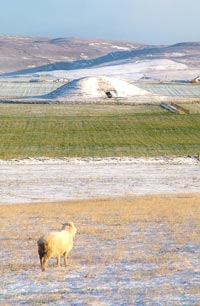
 |
 |
| Home |
| About Orkney |
| History |
| Tradition |
| Folklore |
| Placenames |
| Images |
| Downloads |
| About the Site |
| Contact |
| Links |
| Search Site |
| Awards |
| Maeshowe | |
|
Maeshowe's legendary mound dweller
When Maeshowe was first excavated, in 1861, local tradition regarded it as the home of the unpleasant creature known as the "Hugboy". This ancient individual was definitely a Hogboon, or Haugbui, one of Orkney's many mound-dwelling supernatural creatures. In 1862, Maeshowe’s excavator, James Farrer, wrote: "The country people state that the building (Maeshowe) was formerly inhabited by a person named Hogboy, possessing great strength." No recorded description of Hogboy survives, but Farrer's reference to its extreme strength is an exact parallel to an attribute of the undead creature known as the draugr - in my opinion, the precursor to the Orcadian trow. Another reference to Maeshowe's mound-dweller was written in 1931. It states that: "Seventy years ago there were many stories in the district regarding the 'Hug Boy', but they are now forgotten." As is discussed in the folklore section of this site, behind these tales there is possibly a kernel of truth. In this case, Maeshowe was said to be the home of a particularly unpleasant hogboon, a belief that lasted well into the last century and at least until the time of the tomb's excavation. As is discussed more fully here, the Orkney hogboon developed from the Norse pre-Christian belief in the haugbonde or "howe-farmer". Norse reuse? After death the pagan Norse believed a person's spirit continued to live on, or near, the family farm. This applied in particular to the pioneer, or founding father, of the estate. A large burial mound, a "haugr”, was often built over this individual’s body. This revered ancestor's spirit was thought to remain in this mound, becoming the family's - or farm's - guardian. Regarding Maeshowe, the Hogboon tradition was firmly attached to the cairn, which hints that it was once thought to house an ancestral spirit of some considerable stature. For the tomb to have such strong links to this spirit, it suggests the howe was used as the final resting place of some early Norse founder. An early pre-Christian settler who settled near the tomb and took the land for his own perhaps? This seems to corroborate archaeological evidence suggesting that Maeshowe may have reused as a burial place sometime in the 9th century. Click here to read more. |
The hogboy was not the only strange occupant of Maeshowe. At the time of the excavation some strange reports of discoveries in the tomb made it into the local press. |

